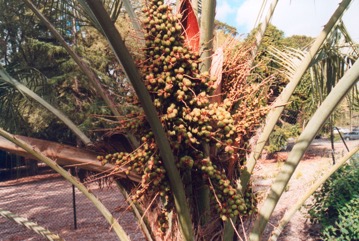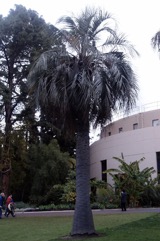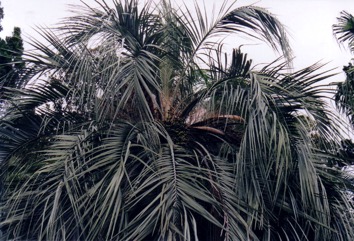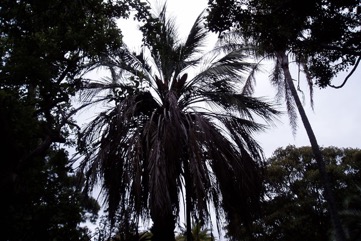Jelly palm, Pindo palm

They can grow in cool climates. It suits temperate and subtropical climates. It is frost hardy. They can tolerate temperatures down to -9°C. They are very wind tolerant. They do best in a sunny position. They are drought tolerant but benefit from watering. They often grow in drier regions. It needs well drained soil. It can grow in arid places. In Melbourne Botanical Gardens. It suits hardiness zones 8-11. Hobart Botanical Gardens. In Townsville palmetum.
Also known as:
Butia, Butia-azedo, Butia-vinagre, Cabecudo, Cabecusa, Cocinho-rastero, Conquinho azedo, Geleepalme, Palem pindo, Palem jelly, Pindo palm
Synonyms
- Butia capitata var. elegantissima (Chabaud) Becc.
- Butia capitata var. erythrospatha (Chabaud) Becc.
- Butia capitata var. lilaceiflora (Chabaud) Becc.
- Butia capitata var. nehrlingiana (I.H.Bailey) L.H. Bailey
- Butia capitata var. odorata (Barb. Rodr.) Becc.
- Butia capitata var. pulposa (Barb. Rodr.) Becc.
- Butia capitata var. strictior L.H.Bailey
- Butia capitata var. subglobosa Becc.
- Butia capitata var. virescens Becc.
- Butia nehrlingiana L.H.Bailey
- Cocos australis Mart.
- Cocos campestris Mart.
- Cocos capitata Mart.
- Cocos elegantissima Chabaud
- Cocos erythrospatha Chabaud
- Cocos lilaceifolia Chabaud
- Cocos odorata Barb. Rodr.
- Cocos pulposa Bar. Rodr.
- Syagrus capitata (Mart.) Glassman
- and others
Edible Portion
- Fruit, Seeds - oil, Stem
Where does Jelly palm grow?
Found in: Africa, Argentina, Asia, Australia, Brazil, Britain, Canada, Central America, Egypt, Indonesia, New Zealand, North Africa, North America, SE Asia, Slovenia, South America, Tasmania, Uruguay, United States, West Indies
Notes: There are about 9 Butea species.
Growing Jelly palm, Pindo palm
Cultivation: Plants are grown from seed. Seed germinate in about 6 months. Seed germinate more quickly if they have been dried and stored. Seed have a hard woody coat which can make them difficult to germinate. Soaking in warm water helps.
Edible Uses: The fruit is eaten fresh and used in jelly. It is also used for wine. The seed is a minor source of oil.
Production: They grow slowly. The fruit is picked as they ripen. If the whole bunch is removed the fruit ripen all at once. The fruit can be stored for about one week under refrigeration.
Nutrition Info
per 100g edible portion| Edible Part | Energy (kcal) | Protein (g) | Iron (mg) | Vitamin A (ug) | Vitamin c (mg) | Zinc (mg) | % Water |
|---|---|---|---|---|---|---|---|
| Fruit | - | 5.8 | - | - | - | - | 87.8 |
| Fruit | 61 | 0.7 | - | - | 32 | 0 | 85.7 |
Jelly palm, Pindo palm Photos




References
Agric. Colon. 10:489, 507, t. 5, figs. 7-8. 1916
Balick, M.J. and Beck, H.T., (Ed.), 1990, Useful palms of the World. A Synoptic Bibliography. Colombia p 122, 360,
Bircher, A. G. & Bircher, W. H., 2000, Encyclopedia of Fruit Trees and Edible Flowering Plants in Egypt and the Subtropics. AUC Press. p 69
Blomberry, A. & Rodd, T., 1982, Palms. An informative practical guide. Angus & Robertson. p 68
Bodkin, F., 1991, Encyclopedia Botanica. Cornstalk publishing, p 178
Brazil: Biodiversity for Food and Nutrition. http://www.b4fn.org/countries/brazil/
Brickell, C. (Ed.), 1999, The Royal Horticultural Society A-Z Encyclopedia of Garden Plants. Convent Garden Books. p 198
Cundall, P., (ed.), 2004, Gardening Australia: flora: the gardener's bible. ABC Books. p 271
Darley, J.J., 1993, Know and Enjoy Tropical Fruit. P & S Publishers. p 83
Etherington, K., & Imwold, D., (Eds), 2001, Botanica's Trees & Shrubs. The illustrated A-Z of over 8500 trees and shrubs. Random House, Australia. p 149
Facciola, S., 1998, Cornucopia 2: a Source Book of Edible Plants. Kampong Publications, p 27
Gibbons, M., 1993, Palms. Compact study Guide and Identifier. Sandstone. p 24
Gibbons, M., 2003, A pocket guide to Palms. Chartwell Books. p 58
Grandtner, M. M. & Chevrette, J., 2013, Dictionary of Trees, Volume 2: South America: Nomenclature, Taxonomy and Ecology. Academic Press p 82
Haynes, J., & McLaughlin, J., 2000, Edible palms and Their Uses. University of Florida Fact sheet MCDE-00-50-1 p 4
Henderson, A., Galeano, G and Bernal, R., 1995, Field Guide to the Palms of the Americas. Princeton. p 137
Hibbert, M., 2002, The Aussie Plant Finder 2002, Florilegium. p 48
Hunter, D., et al, 2019, The potential of neglected and underutilized species for improving diets and nutrition. Planta (2019) 250:709-729
Janick, J. & Paul, R. E. (Eds.), 2008, The Encyclopedia of Fruit & Nuts. CABI p 106
Jones, D.L., 1994, Palms throughout the World. Smithtonian Institution, Washington. p 55, 151
Jones, D.L., 2000, Palms of Australia 3rd edition. Reed/New Holland. p 126
Kinupp, V. F., 2007, Plantas alimenticias nao-convencionais da regiao metropolitana de Porto Alegre, RS, Brazil p 63
Kinupp, V. F. & Bergman, I., 2008, Protein and minerals of native species, potential vegetables and fruits. Cienc.Tecnol. Aliment. Vol. 28 No. 4 Campinas Oct/Dec.
Kiple, K.F. & Ornelas, K.C., (eds), 2000, The Cambridge World History of Food. CUP p 1792
Llamas, K.A., 2003, Tropical Flowering Plants. Timber Press. p 96
Lord, E.E., & Willis, J.H., 1999, Shrubs and Trees for Australian gardens. Lothian. p 94
Lorenzi, H., Bacher, L., Lacerda, M. & Sartori, S., 2006, Brazilian Fruits & Cultivated Exotics. Sao Paulo, Instituto Plantarum de Estuados da Flora Ltda. p 72
Lyle, S., 2006, Discovering fruit and nuts. Land Links. p 308
Marinelli, J. (Ed), 2004, Plant. DK. p 362
Martin, F. W., et al, 1987, Perennial Edible Fruits of the Tropics. USDA Handbook 642 p 47
Pereira, M. C., et al, 2012, Characterisation, bioactive compounds and antioxidant potential of three Brazilian fruits. Journal of Food Composition and Analysis. 29(2013):19-24
Plants for a Future database, The Field, Penpol, Lostwithiel, Cornwall, PL22 0NG, UK. http://www.scs.leeds.ac.uk/pfaf/
Recher, P, 2001, Fruit Spirit Botanical Gardens Plant Index. www.nrg.com.au/~recher/ seedlist.html p 7
Riffle, R.L. & Craft, P., 2003, An Encyclopedia of Cultivated Palms. Timber Press. p 282
Royal Botanic Gardens, Kew (1999). Survey of Economic Plants for Arid and Semi-Arid Lands (SEPASAL) database. Published on the Internet; http://www.rbgkew.org.uk/ceb/sepasal/internet [Accessed 5th May 2011]
Schuler, S., (Ed.), 1977, Simon & Schuster's Guide to Trees. Simon & Schuster. No. 49
Sukarya, D. G., (Ed.) 2013, 3,500 Plant Species of the Botanic Gardens of Indonesia. LIPI p 760
Tankard, G., 1990, Tropical fruit. An Australian Guide to Growing and using exotic fruit. Viking p 109
World Checklist of Useful Plant Species 2020. Royal Botanic Gardens, Kew